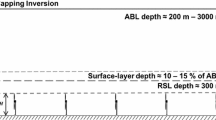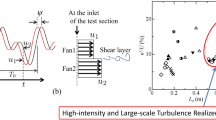Abstract
This paper describes wind-tunnel experiments on the flow around single and multiple porous windbreaks (height H), sheltering a model plant canopy (height H/3). The mean wind is normal to the windbreaks, which span the width of the wind tunnel. The incident turbulent flow simulates the adiabatic atmospheric surface layer. Five configurations are examined: single breaks of three solidities (low, medium, high; solidity = 1 - porosity), and medium-solidity multiple breaks of streamwise spacing 12H and 6H. The experimental emphases are on the interactions of the windbreak flow with the underlying plant canopy; the effects of solidity; the differences in shelter between single and multiple windbreaks; and the scaling properties of the flow. Principal results are: (1) the "quiet zones" behind each windbreak are smaller in multiple than single arrays, because of the higher turbulence level in the very rough-wall internal boundary layer which develops over the multiple arrays. Nevertheless, the overall shelter effectiveness is higher for multiple arrays than single windbreaks because of the "nonlocal shelter" induced by the array as a whole. (2) The flow approaching the windbreak decelerates above the canopy but accelerates within the canopy, particularly when the windbreak solidity is high. (3) A strong mixing layer forms just downwind of the top of each windbreak, showing some of the turbulence and scaling properties of the classical mixing layer formed between uniform, coflowing streams. (4) No dramatic increase in turbulence levels in the canopy is evident at the point where the deepening mixing layer contacts the canopy (around x/H = 3) but the characteristic inflection in the canopy wind profile is eliminated at this point.
Similar content being viewed by others
References
Argent, R. M.: 1990, ‘Wind Shelter and Crop Protection’, M. Eng. Sci. Thesis, University of Western Ontario, London, Ontario, Canada.
Baltaxe, R.: 1967, ‘Airflow Patterns in the Lee of Model Windbreaks’, Arch. Meteorol. Geophys. Bioklimatol. Series B. 15, 287–312.
Bean, A., Alperi, R. W., and Federer, C. A.: 1975, ‘A Method for Categorizing Shelterbelt Porosity’, Agric. Meteorol. 14, 417–429.
Bradley, E. F. and Mulhearn, P. J.: 1983, ‘Development of Velocity and Shear Stress Distributions in the Wake of a Porous Shelter Fence’, J. Wind Eng. Ind. Aerodyn. 15, 145–156.
Brunet, Y., Finnigan, J. J., and Raupach, M. R.: 1994, ‘A Wind Tunnel Study of Air Flow in Waving Wheat: Single Point Velocity Measurements’, Boundary-Layer Meteorol. 70, 95–132.
Castro, I. P.: 1971, ‘Wake Characteristics of Two-Dimensional Perforated Plates Normal to an Air Stream’, J. Fluid Mech. 46, 599–609.
Castro, I. P. and Haque, A.: 1987, ‘The Structure of a Turbulent Shear Layer Bounding a Separation Region’, J. Fluid Mech. 179, 439–468.
Castro, I. P. and Haque, A.: 1988, ‘The Structure of a Shear Layer Bounding a Separation Region. Part 2. Effects of Free-Stream Turbulence’, J. Fluid Mech. 192, 577–595.
Counihan, J., Hunt, J. C. R., and Jackson, P. S.: 1974, ‘Wakes Behind Two-Dimensional Surface Obstacles in Turbulent Boundary Layers’, J. Fluid Mech. 64, 529–563.
Finnigan, J. J. and Bradley, E. F.: 1983, ‘The Turbulent Kinetic Energy Budget Behind a Porous Barrier: An Analysis in Streamline Coordinates’, J. Wind Eng. Ind. Aerodyn. 15, 157–168.
Finnigan, J. J. and Brunet, Y.: 1995, ‘Turbulent Airflow in Forests on Flat and Hilly Terrain’, in M. P. Coutts and J. Grace (eds.), Proc. IUFRO Conf. on Wind and Wind-Related Damage to Trees, Edinburgh, 1993, pp. 3–40, Cambridge University Press: Cambridge.
Finnigan, J. J. and Mulhearn, P. J.: 1978, ‘Modelling Waving Crops in a Wind Tunnel’, Boundary-Layer Meteorol. 14, 253–277.
Gandemer, J.: 1981, ‘The Aerodynamic Characteristics of Windbreaks Resulting in Empirical Design Rules’, J. Wind Eng. Ind. Aerodyn. 7, 15–36.
Guyot, G.: 1986, Manual sur lutilisation des brise-vents dans les zones arides, FAO, Rome.
Guyot, G. and Seguin, B.: 1975, ‘Modification of Land Roughness and Resulting Microclimatic Effects: A Field Study in Brittany’, in D. A. de Vries and N. H. Afgan (eds.), Heat and Mass Transfer in the Biosphere, Part I: Transfer Process in the Plant Environment, Scripta Book Co., New York, pp. 467–478.
Hagen, L. J. and Skidmore, E. L.: 1971, ‘Turbulent Velocity Fluctuations and Vertical Flow as Affected by Windbreak Porosity’, Trans. ASAE 14, 634–637.
Heisler, G. M. and De Walle, D. R.: 1988, ‘Effects of Windbreak Structure on Wind Flow’, Agric. Ecosystems Environ. 22/23, 41–69.
Iqbal, M., Khotry, A. K., and Seguin, B.: 1977, ‘A Study of the Roughness Effects of Multiple Windbreaks’, Boundary-Layer Meteorol. 11, 187–203.
Jackson, P. S.: 1981, ‘On the Displacement Height in the Logarithmic Velocity Profile’, J. Fluid Mech. 111, 15–25.
Jensen, M.: 1958, ‘The Model Law for Phenomena in the Natural Wind’, Igenioren, Int. Edn. 2, 121–128.
Kaimal, J. C. and Finnigan, J. J.: 1994, Atmospheric Boundary Layer Flows: Their Structure and Measurement, Oxford University Press, Oxford, 289 pp.
Konstantinov, A. R. and Struzer, L. R.: 1965, ‘Shelterbelts and Crop Yields’, Translated by A. Barach. Israel Program for Scientific Translations, 1969, US Dept. of Commerce. Springfield, Va., 138 pp.
Laws, E. M. and Livesey, J. L.: 1978, ‘Flow Through Screens’, Ann. Rev. Fluid Mech. 10, 247–266.
Legg, B. J., Coppin, P. A., and Raupach, M. R.: 1984, ‘A Three-Hot-Wire Anemometer for Measuring Two Velocity Components in High Intensity Boundary Layers’, J. Phys. E. 17, 970–976.
McAneney, K. J. and Judd, M. J.: 1987, ‘Comparative Shelter Strategies for Kiwifruit: A Mechanistic Interpretation of Wind Damage Measurements’, Boundary-Layer Meteorol. 54, 129–146.
McAneney, K. J. and Judd, M. J.: 1991, ‘Multiple Windbreaks: An Aeolian Ensemble’, Agric. For. Meteorol. 39, 225–250.
McNaughton, K. G.: 1988, ‘Effects of Windbreaks on Turbulent Transport and Microclimate’, Agric. Ecosystems Environ. 22/23, 17–39.
Mulhearn, P. J. and Finnigan, J. J.: 1978, ‘Turbulent Flow over a Very Rough, Random Surface’, Boundary-Layer Meteorol. 15, 109–132.
Nord, M.: 1991, ‘Shelter Effects of Vegetation Belts — Results of Field Measurements’, Boundary-Layer Meteorol. 54, 363–385.
Panofsky, H. E. and Dutton, J. A.: 1984, Atmospheric Turbulence: Models and Methods for Engineering Applications, Wiley, New York, 397 pp.
Perera, M. D. A. E. S.: 1981, ‘Shelter Behind Two Dimensional Solid and Porous Fences’, J. Wind Eng. Ind. Aerodyn. 8, 93–104.
Plate, E. J.: 1971a, ‘Aerodynamic Characteristics of Atmospheric Boundary Layers’, US Atomic Energy Commission, Office of Information Services, Oak Ridge.
Plate, E. J.: 1971b, ‘The Aerodynamics of Shelter Belts’, Agric. Meteorol. 8, 203–222.
Raine, J. K. and Stevenson, D. C.: 1977, ‘Wind Protection by Model Fences in a Simulated Atmosphere Boundary Layer’, J. Ind. Aerodyn. 2, 159–180.
Raupach, M. R.: 1988, ‘Canopy Transport Processes’, in W. L. Steffen and O. T. Denmead (eds.), Flow and Transport in the Natural Environment: Advances and Applications, Springer-Verlag, Berlin, pp. 95–127.
Raupach, M. R., Thom, A. S., and Edwards, I.: 1980, ‘A Wind Tunnel Study of Turbulent Flow Close to Regularly Arrayed Rough Surfaces’, Boundary-Layer Meteorol. 18, 373–397.
Raupach, M. R., Coppin, P. A., and Legg, B. J.: 1986, ‘Experiments on Scalar Dispersion within a Model Plant Canopy, Part I: The Turbulence Structure’, Boundary-Layer Meteorol. 35, 21–52.
Rogers, M. M. and Moser, R. D.: 1994, ‘Direct Simulation of a Self-Similar Turbulent Mixing Layer’, Phys. Fluids 6, 903–923.
Ruderich, R. and Fernholz, H. H.: 1986, ‘An Experimental Investigation of a Turbulent Shear Flow with Separation, Reverse Flow, and Reattachment’, J. Fluid Mech. 163, 283–322.
Schlichting, H.: 1968, Boundary Layer Theory, McGraw-Hill, New York, 747 pp.
Seguin, B. and Gignoux, M.: 1974, ‘Etude expérimentale de l'influence d'un réseau de brise-vent sur le profile vertical de vitesse du vent’, Agric. Meteorol. 13, 15–33.
Sturrock, J. W.: 1969, ‘Aerodynamic Studies of Shelterbelts in New Zealand - 1: Low to Medium-Height Shelterbelts in Mid-Canterbury’, N.Z. J. Sci. 12, 754–776.
Thom, A. S.: 1971, ‘Momentum Absorption by Vegetation’, Quart. J. Roy. Meteorol. Soc. 97, 414–428.
Townsend, A. A.: 1976, The Structure of Turbulent Shear Flow, Cambridge University Press, Cambridge, 429 pp.
Van Eimern, J., Karschon, R., Razumova, L. A., and Robertson, G. W.: 1964, ‘Windbreaks and Shelterbelts’, WMO Technical Note No. 59 (WMO No. 147.TP.70), 188 pp.
Wang, Zhengquan, Shi, Jiachen, and Wang, Yehchu: 1990, ‘Application of the Boundary Layer Models to Simulate Wind Velocity Profiles of Shelterbelts’, in Xiang, Kaifu, Shi, Jiachen, Baer, N. M., and Sturrock, J. W. (eds.), Protective Plantation Technology, Publishing House of Northeast Forestry University, China.
Wilson, J. D.: 1985, ‘Numerical Studies of Flow Through a Windbreak’, J. Wind Eng. Ind. Aerodyn. 21, 119–154.
Wilson, J. D.: 1987, ‘On the Choice of a Windbreak Porosity Profile’, Boundary-Layer Meteorol. 38, 37–49.
Wilson, J. D., Swaters, G. E., and Ustina, F.: 1990, ‘A Perturbation Analysis of Turbulent Flow through a Porous Barrier’, Quart. J. Roy. Meteorol. Soc. 116, 989–1004.
Wooding, R. A.: 1968, ‘A Low Speed Wind Tunnel for Model Studies in Micrometeorology. II. The Pye Laboratory Wind Tunnel’, Aust. CSIRO Div. Plant Ind. Tech. Pap. No. 25, pp. 1–24.
Woodruff, P. N. and Zingg, A. W.: 1955, ‘A Comparative Analysis of Wind Tunnel and Atmospheric Air Flow Patterns about Single and Successive Barriers’, Trans. Amer. Geophys. Union 36, 203–208.
Wygnanski, I. and Fiedler, H. E.: 1970, ‘The Two Dimensional Mixing Region’, J. Fluid Mech. 41, 327–361.
Zhuang, Y. and Wilson, J. D.: 1994, ‘Coherent Motions in Windbreak Flow’, Boundary-Layer Meteorol. 70, 151–169.
Author information
Authors and Affiliations
Rights and permissions
About this article
Cite this article
Judd, M.J., Raupach, M.R. & Finnigan, J.J. A wind tunnel study of turbulent flow around single and multiple windbreaks, part I: Velocity fields. Boundary-Layer Meteorol 80, 127–165 (1996). https://doi.org/10.1007/BF00119015
Accepted:
Issue Date:
DOI: https://doi.org/10.1007/BF00119015




